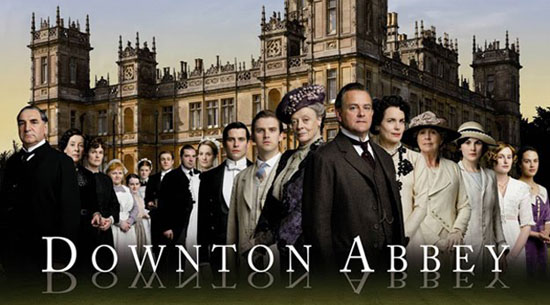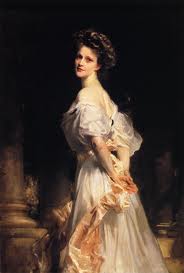
Previous installments in this series can be found here. There will be spoilers. “An historian” is a perfectly acceptable Commonwealth convention, haters to the left [side of the road.]
The things that bother me most about Downton Abbey are not simply about historical accuracy. I think that historical accuracy is a complicated issue and not actually easy to get right. How do you write dialogue for characters that would have used slang that would now be incomprehensible or misunderstood? The average British actor is a great deal more robust-looking than the average Yorkshire servant would have been a century ago; should the show’s make-up and casting reflect that? It’s hard to draw the line between reasonable accuracy and antiquarianism, and in many respects I think the show does well.
Much more disturbing to me are the occasional intrusions of graphic suffering, or perhaps I should say, the uneven pattern of those intrusions. It is saying something, in a show that had scenes actually set in the trenches of the Western Front during World War I, that the most viscerally violent and distressing scenes have been a death in childbirth and a rape. There is a willingness to wallow in images of the female body in agony, and a commensurate squeamishness about male suffering (even Matthew looked barely dented in the aftermath of his crash), that is unsettling, especially since it seems to come out of the blue, narratively speaking. This is not a show that depicts the gritty reality of life, except when suddenly it does, and it usually only sacrifices women to that end.
 With all that said, Sunday night’s episode did capture the intense vulnerability of domestic servants, especially women. At times Lord Grantham acts more like a utopian philanthropist landowner than the hidebound aristocrat he’s meant to be. Mrs. Patmore’s eye treatment paid for by her employers, sneezing maids sent to bed, Molesley kept on for six months without any real employment—it’s easy, most weeks, to forget how desperately insecure most domestic servants were, and how vulnerable to mistreatment of all kinds.
With all that said, Sunday night’s episode did capture the intense vulnerability of domestic servants, especially women. At times Lord Grantham acts more like a utopian philanthropist landowner than the hidebound aristocrat he’s meant to be. Mrs. Patmore’s eye treatment paid for by her employers, sneezing maids sent to bed, Molesley kept on for six months without any real employment—it’s easy, most weeks, to forget how desperately insecure most domestic servants were, and how vulnerable to mistreatment of all kinds.
Domestic service remained a major employer, though declining, for women in the first half of the twentieth century. Service jobs of various kinds are still common, of course, even though customs and vocabulary have shifted; the gap between the nannies and cleaners of the 21st century and the servants of Downton’s world is not as big as we’d like to think. According to the 1891 census in England and Wales, 41 percent of the female labour force was in domestic service; the comparable number in 1931 was 24 percent, though there was an even larger dip right around World War I. In her beautiful memoir, Lark Rise to Candleford, Flora Thompson poignantly describes adolescent girls leaving their hamlet homes in rural Oxfordshire and heading out to service in the late nineteenth century, while their brothers stayed home and worked as agricultural laborers. By the time of Downton Abbey, these girls had other options: if not staying in school slightly longer, then taking up jobs as secretaries, typists, shopgirls, or workers in the new light industries of the south.
 They were, in many cases, escaping not so much drudgery or hard work—that was unavoidable—as the suffocating power relations and lack of independence that were inherent to domestic service, especially for servants who lived in their workplaces. They faced a range of annoyances, from bad-tempered or overly strict masters and mistresses to humiliating rituals and requirements—Lady Astor (pictured), the first woman to take up a seat in Parliament, reportedly shared chocolates with her maid, but only after biting them first to see if she liked the flavor.
They were, in many cases, escaping not so much drudgery or hard work—that was unavoidable—as the suffocating power relations and lack of independence that were inherent to domestic service, especially for servants who lived in their workplaces. They faced a range of annoyances, from bad-tempered or overly strict masters and mistresses to humiliating rituals and requirements—Lady Astor (pictured), the first woman to take up a seat in Parliament, reportedly shared chocolates with her maid, but only after biting them first to see if she liked the flavor.
Sexual harassment of various kinds formed one element of these troubles. The historian of domestic service Lucy Delap quotes one woman who remembered of her employers: “the woman was harsh and the man too friendly. I couldn’t lock my bedroom so I put a chair behind [the door, so that] at least there would be a clatter if he did try to visit me—but I measured my waist with a tape measure each morning in case he had given me a baby in the night in my sleep! I was 22 but we didn’t know much in those days.”
In my own research on Irish immigrants to England, I came across another story in the 1933-34 annual report of the Liverpool Society for the Prevention of International White Slave Traffic, a group that allowed ladies in the mold of Isobel Crawley to help young women find suitable jobs and lead worthy lives. Two young women, aged 20 and 21, arrived from in Liverpool on the boat from Cork with an address in Cheshire where they had jobs waiting as a housemaid and a cook. In the words of the Liverpool Society:
Two months later we had a letter saying they were very unhappy. They had to do all the cooking and housework, and in addition look after Alsatian dogs, also clean the daughter’s car. They were only allowed out very occasionally, but never together. They had not received any wages except a shilling each time they went out, and their Insurance cards had not been stamped. The master of the house had tried to seduce one of the girls, and this had made them scared to be left in alone.
Ultimately the Society intervened, with support from the law, and obliged the employers to “stamp the cards up to date and pay full wages due to the girls, who were at once removed and helped to obtain very good reliable positions.”
By the thirteenth century, rape was defined in English common law as forcible sex against the victim’s will; the Statutes of Westminster introduced the idea of an age of consent and set hanging as the penalty for rape. In the seventeenth century, the jurist Sir Matthew Hale wrote, influentially and distressingly, about the need to consider the character of the accuser in rape cases; famously, he said that rape “is an accusation easily to be made and hard to be proved.” In portraying Anna as the upstanding and resisting victim of Lord Gillingham’s valet, Downton Abbey nods to prejudices about the nature of rape that have persisted, then, for centuries. Over the course of the nineteenth century, penalties for rape were lessened (to transportation and then to imprisonment), while the age of consent was raised. Marital rape was defined as an impossibility from the seventeenth century until the very late twentieth century, the argument being that marriage itself implied consent in perpetuity. However, the Divorce Court increasingly recognized limits to the sexual demands that husbands could legitimately make; knowingly and recklessly communicating venereal disease, for example, was defined as cruelty by the case of Boardman v. Boardman (1866).
Domestic servants, then, like other working-class women, faced a pervasive risk of sexual assault. As usual, though, Downton Abbey blurs the real power dynamics that usually underpinned that risk: Anna was at far greater risk from Lord Grantham or other ‘upstairs’ men, and in the case of Mr. Bates, she literally couldn’t have said no, legally, in 1922. And Edna Braithwaite, of course, is fairly implausible as the full-on sexual predator she seems to have become by the end of the episode; the balance of power is nearly all on Branson’s side there. It’s not, ultimately, than any of these story lines are inaccurate, but that they obscure the larger patterns of power and abuse, and they do so in a way that seems to fetishize the suffering female body.
Sources
Lucy Delap, Knowing Their Place: Domestic Service in Twentieth-Century Britain (Oxford University Press, 2011)
Gail Savage, “‘… the instrument of an animal function’: Marital Rape and Sexual Cruelty in the Divorce Court, 1858-1908,” in The Politics of Domestic Authority in Britain since 1800 ed. Lucy Delap and Ben Griffin (Palgrave Macmillan: Houndmills, Basingstoke, 2009)
“Rape,” in The Oxford International Encyclopedia of Legal History, edited by Katz, Stanley N. (Oxford: Oxford University Press, 2009)
